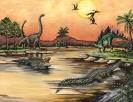Chinese civilization originated in various regional centers along both the Yellow River and the Yangtze River valleys in the Neolithic era, but the Yellow River is to be said as the Cradle of Chinese Civilization. The written history of China can be found as early as the Shang Dynasty (ca. 1700 BC – ca. 1046 BC). Oracle bones with ancient Chinese writing from the Shang Dynasty have been radiocarbon dated to as early as 1500 BC. The origins of Chinese culture, literature and philosophy developed during the Zhou Dynasty (1045 BC-256 BC).
The Zhou Dynasty began to bow to external and internal pressures in the 8th century BC. The ability of the Zhou to control its regional lords lessened, and the kingdom eventually broke apart into smaller states, beginning in the Spring and Autumn Period and reaching full expression in the Warring States period. In 221 BC, Qin Shi Huang united the various warring kingdoms and created the first Chinese empire. Successive dynasties in Chinese history developed bureaucratic systems that enabled the Emperor of China to directly control vast territories.
The conventional view of Chinese history is that of alternating periods of political unity and disunity, with China occasionally being dominated by Inner Asian peoples, most of whom were in turn assimilated into the Han Chinese population. Cultural and political influences from many parts of Asia, carried by successive waves of immigration, expansion, and cultural assimilation, are part of the modern culture of China.
The Han Dynasty (202 BC – AD 220) emerged in 206 BC, with its founder Liu Bang proclaimed emperor in 202 BC. It was the first dynasty to embrace the philosophy of Confucianism, which became the ideological underpinning of all regimes until the end of imperial China. Under the Han Dynasty, China made great advances in many areas of the arts and sciences. This enabled the first opening of trading connections between China and the West, along the Silk Road. The first of several Roman embassies to China is recorded in Chinese sources, coming from the sea route in AD 166, and a second one in AD 284.
Emperor Guangwu reinstated the Han Dynasty with the support of landholding and merchant families at Luoyang, east of Xi'an. This new era would be termed the Eastern Han Dynasty. Han power declined again amidst land acquisitions, invasions, and feuding between consort clans and eunuchs. The Yellow Turban Rebellion broke out in AD 184, ushering in an era of warlords. In the ensuing turmoil, three states tried to gain predominance in the period of the Three Kingdoms. This time period has been greatly romanticized in works such as Romance of the Three Kingdoms.
The Qing Dynasty (1644–1911) was founded after the defeat of the Ming, the last Han Chinese dynasty, by the Manchus. When Beijing was captured by Li Zicheng's peasant rebels in 1644, the last Ming Emperor Chongzhen committed suicide. The Manchu then allied with Ming Dynasty general Wu Sangui and seized control of Beijing, which became the new capital of the Qing dynasty. The Manchus adopted the Confucian norms of traditional Chinese government in their rule of China proper.

No comments:
Post a Comment